Closed Exhibition - Light from the Middle East: New Photography
Light from the Middle East: About the Exhibition
13 November 2012 - 7 April 2013

Nermine Hammam, 'The Break', from the series 'Upekkha', 2011. Museum no. E.1129-2012. The Art Fund Collection of Middle Eastern Photography at the V&A and the British Museum
Photography is a powerful and persuasive means of expression. Its immediacy and accessibility make it an ideal choice for artists confronting the social challenges and political upheavals of the Middle East today.
Light from the Middle East: New Photography presented work by artists from across the Middle East (spanning North Africa to Central Asia), living in the region and in diaspora.
The exhibition explored the ways in which these artists investigate the language and techniques of photography. Some use the camera to record or bear witness, while others subvert that process to reveal how surprisingly unreliable a photograph can be. The works range from documentary photographs and highly staged tableaux to images manipulated beyond recognition. The variety of approaches is appropriate to the complexities of a vast and diverse region.
Light from the Middle East was divided into three sections, Recording, Reframing and Resisting, each of which focuses on a different approach to the medium of photography.
Recording
Photography is a seemingly accurate means of recording people, places and events. A photograph can serve a commemorative purpose or document a historic moment. It can reveal something not otherwise visible, such as a place or event the viewer would not have access to, or a particular vantage point available only to the photographer. It can also create a lasting image of a fleeting performance, or of a scene staged only for the camera.
But how reliable is a photograph? Despite the apparent authority of photographic images, they can trick or disorient. They can be ambiguous and difficult to decipher. Their meaning can shift according to context, cropping or captioning. What are the limitations of photography?
The photographers in this section use a range of approaches to exploit and explore the camera’s capacity to record.
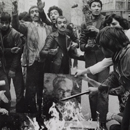
Abbas, 'Rioters burn a portrait of the Shah as a sign of protest against his regime. Tehran, December 1978', from the series 'IranDiary'
Abbas
Born Kash, Iran, 1944. Lives Paris, France
'Rioters burn a portrait of the Shah as a sign of protest against his regime. Tehran, December 1978', from the series 'IranDiary'
1978–9
Gelatin silver print
British Museum: 2010, 6034.4
Art Fund Collection of Middle Eastern Photography at the V&A and the British Museum
Abbas@Magnum Photos, courtesy Magnum GalleryAbbas is a veteran photojournalist who has been covering world events since the 1970s. He joined the Magnum photographic agency in 1981 and went on to serve as President from 1998 to 2001. His graphic depictions of the Iranian revolution are among his best-known works. They bear witness to dramatic events while acknowledging the power of the photographic image, as in this depicion of protestors burning a photograph of the Shah.

Mehraneh Atashi, 'Bodiless I', from the series 'Zourkhaneh Project' (House of Strength)
Mehraneh Atashi
Born Tehran, Iran, 1980. Lives Tehran
'Bodiless I', from the series 'Zourkhaneh Project (House of Strength)'
2004
Digital c-print
British Museum: 2099, 6035.1
Art Fund Collection of Middle Eastern Photography at the V&A and the British MuseumMehraneh Atashi explores the relationship between photography and power in her ongoing investigation into the possibilities of self-portraiture. Her photographic series reveal lesser-known aspects of Iranian life.
This photograph shows the inside of a zurkhana, a traditional Iranian wrestling gym, in Tehran. The artist has explained that ‘tradition forbids the breath of women’ in the zurkhana. Atashi includes herself in the scene through a reflection in a mirror. This picture within a picture emphasises her incongruous presence in a place from which women are normally excluded.

Newsha Tavakolian, from the series 'Mothers of Martyrs'
Newsha Tavakolian
Born Tehran, Iran, 1981. Lives Tehran
From the series 'Mothers of Martyrs'
2006
Digital c-print
Museum no. E.357-2010
Art Fund Collection of Middle Eastern Photography at the V&A and the British MuseumNewsha Tavakolian started her career at the age of 16, as a junior photographer for the Iranian women’s daily Zan-e Rooz. She also worked with other reformist newspapers and by the early 1990s had established herself as one of Tehran’s few female photojournalists, working internationally and particularly focussing on women’s issues. She is a founder member of the EVE international collective of women photojournalists, established in 2006 and of Rawiya, a collective of women photographers from the Middle East, founded in 2011. Her series 'Mothers of Martyrs' shows elderly Iranian women holding framed photographs of their sons who died decades earlier in the Iran–Iraq war (1980–8). The double portraits attest to photography’s emotive power.
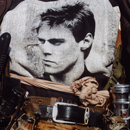
Abbas Kowsari, 'Halabche'
Abbas Kowsari
Born Tehran, Iran, 1970. Lives Tehran
'Halabche'
2003
Digital c-print
British Museum: 2009, 6031.1
Art Fund Collection of Middle Eastern Photography at the V&A and the British MuseumAbbas Kowsari began his career as a photojournalist for the Tehran Times in 1994 and is currently Senior Picture Editor for Shargh, a popular reformist title.
This photograph made in nothern Iraq presents a portrait within a portrait. The figure of a peshmerga (a Kurdish combatant) is tightly framed to exclude his face. Instead, the face of rock musician Bryan Adams, on the soldier’s T-shirt, fills a central portion of the composition. The faded black-and-white image is surrounded by saturated colours and brightly gleaming metal. The contrast reinforces the incongruity between warfare in Iraq and western pop culture.
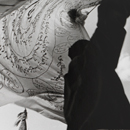
Issa Touma, from the series 'Sufis: The day of al-Ziyara'
Issa Touma
Born Safita, Syria, 1962. Lives Aleppo, Syria
From the series 'Sufis: The day of al-Ziyara'
1995–2005
Gelatin silver print
Museum no. E.71-2011
Art Fund Collection of Middle Eastern Photography at the V&A and the British MuseumIssa Touma is a prominent figure in the Syrian art scene. Self-taught, he began his career as a photographer in the early 1990s. In 1996 he founded Le Pont Organisation and Gallery, an independent art organisation to promote freedom of expression and stimulate the local art scene through international events.
His series on the day of al-Ziyara documents an annual procession of Sufi pilgrims in northern Syria. Sufism is a mystical path within Islam. Touma photographed the event over the course of ten years, gradually gaining the trust of his subjects. The resulting images convey his sense of immersion in the festival and capture the fervour of the worshippers.
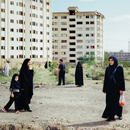
Mitra Tabrizian, 'Tehran 2006'
Mitra Tabrizian
Born Tehran, Iran.
Lives London, UK
'Tehran 2006'
2006
Digital c-print
Museum no. E.470-2008Mitra Tabrizian examines what she calls 'the crisis of contemporary culture in both the West and the East', often expressing social displacement or alienation through disquieting and sometimes staged photographic tableaux. She works with non-professional models, ordinary people who play themselves, and photographs them all at once, without digital manipulation. Here a disparate group of people appear to go about everyday business in a residential area on the outskirts of Tehran. The surroundings suggest a society without a working infrastructure. There are no gardens, street lighting or proper roads. A metaphorical exploration of isolation and exile, this image also reflects a nation with mounting ideological and religious tensions.
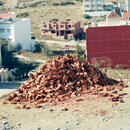
Yto Barrada, 'Bricks (Briques)'
Yto Barrada
Born Paris, France, 1971. Lives Tangier, Morocco
'Bricks (Briques)'
2003/2011
C-print
Museum no. E.1132-2012
Art Fund Collection of Middle Eastern Photography at the V&A and the British MuseumYto Barrada grew up in Paris and Tangier and studied in Paris and New York. Since 2006 she has directed the Cinématèque de Tanger, a cultural centre home to an archive of Maghrebi and Arabic film and video. Barrada’s hometown of Tangier is the subject of much of her work. In this view, recently constructed buildings in various states of completion are scattered across the hillsides. The pile of bricks in the foreground seems to parallel the haphazard nature of the surrounding building projects. The untidy man-made heap echoes the form of the natural hills in the background.
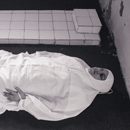
Waheeda Malullah, from the series 'Light'
Waheeda Malullah
Born Bahrain, 1978. Lives Bahrain
From the series 'Light'
2006
Inkjet print on rag paper
British Museum: 2010, 6031.2
Art Fund Collection of Middle Eastern Photography at the V&A and the British MuseumWaheeda Malullah uses playfulness and humour to explore social rules, and in particular the roles women play in Islamic society. In the series 'Light' she records a performance staged expressly for the camera. By lying down next to tombs in Bahrain she exaggerates the Shi'i Muslim custom of seeking blessing by touching the tombs of revered people. These stylised compositions are also studies of form, light and shadow.
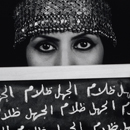
Manal Al-Dowayan, 'I am an Educator'
Manal Al-Dowayan
Born Dhahran, Saudi Arabia, 1973. Lives Dhahran
'I am an Educator'
2005–7
Gelatin silver print
British Museum: 2009, 6034.1
Art Fund Collection of Middle Eastern Photography at the V&A and the British MuseumManal Al-Dowayan uses photography, text and installation to examine Saudi identity, and in particular the role of women in contemporary society. Working mainly in black and white photography, she also experiments with other media and techniques, often combining images with Arabic text. The sitter for 'I am an Educator' is a professor of English literature in Saudi Arabia. The phrase repeated on her slate means 'Ignorance is darkness'. The rest of this Arabic saying, 'Knowledge is light', is omitted.
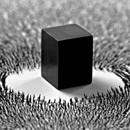
Ahmed Mater, 'Magnetism II'
Ahmed Mater
Born Tabuk, Saudi Arabia, 1979. Lives Abha, Saudi Arabia
'Magnetism II'
2012
Photogravure
British Museum: 2012, 6018.1 to 2
Acquired thanks to Mr Abdulaziz al-TurkiAhmed Mater is a Saudi artist and qualified GP. Working in photography, calligraphy, painting, installation and video, Mater reflects his experiences as a doctor and the ways this has challenged his traditional background and beliefs, and explores wider issues about Islamic culture in an era of globalisation. In the series 'Magnetism', what at first appear to be pilgrims circling the Ka'ba, the sacred building at the heart of the sanctuary at Mecca, are in fact iron filings spiralling around a cube-shaped magnet. Mater refers to the spiritual force that Muslim believers feel during Hajj, the pilgrimage to Mecca. By creating photographs that recall well-known images on a dramatically different scale, Mater also questions the reliability of photography.
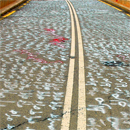
Abdulnasser Gharem, 'The Path (Siraat)'
Abdulnasser Gharem
Born Khamis Mushait, Saudi Arabia, 1973. Lives Riyadh, Saudi Arabia
'The Path (Siraat)'
2009
Inkjet print on aluminium
British Museum: 2009, 6033.1
Art Fund Collection of Middle Eastern Photography at the V&A and the British MuseumAbdulnasser Gharem works across a variety of media to explore local Saudi issues. Amongst his best-known works are 'stamp paintings', made from industrial paint on rubber stamps, a technique devised to negotiate and comment on censorship. He combines service in the Saudi armed forces (he is currently Lieutenant Colonel) with his activities as an artist.
The subject of this photograph is a bridge in southern Saudi Arabia that was severely damaged in the early 1980s when villagers attempted to take shelter on it during a flash flood. Instead of providing a safe high ground above the floodwaters the bridge collapsed, resulting in the loss of many lives. Gharem spray-painted the word siraat repeatedly on the bridge. The word means path, and in the Qur'an it refers to 'the path to God'.
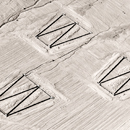
Jananne Al-Ani, still from 'Shadow Sites II'
Jananne Al-Ani
Born Kirkuk, Iraq, 1966. Lives London, UK
Still from 'Shadow Sites II'
2011
Single channel digital video. Duration 8 mins 38 secs
Photography by Adrian Warren
Courtesy the Artist and Rose Issa Projects, LondonAl-Ani works with photography, film and video, producing bodies of work that explore the power of testimony and interrogate the documentary tradition, often characterised by an interweaving of intimate recollections of loss and trauma with more formal, official accounts of historic events.
This is a still from a video composed of a series of aerial views, which show that the desert is inhabited and not the unoccupied wilderness it is sometimes believed to be. The title draws on a phenomenon familiar to archaeologists: when the sun is at its lowest, shadows make visible the remains of otherwise undetectable settlements. Al-Ani’s images are presented without explanation and the scale of the landscapes is difficult to interpret. They are deliberately ambiguous and point to the limitations of photography.
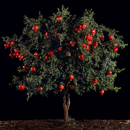
Tal Shochat, 'Pomegranate (Rimon)'
Tal Shochat
Born Netanya, Israel, 1974. Lives Tel Aviv, Israel
'Pomegranate (Rimon)'
2010
C-print
Museum no. E.1127–2012
Art Fund Collection of Middle Eastern Photography at the V&A and the British MuseumIn her photographs Shochat stages both figures and objects to create symbolically-laden images that often question the boundary between nature and artifice. Here she applies the conventions of studio portraiture to photographing trees. The first stage in her meticulous process is to identify the perfect specimen of a particular type of tree. When the fruit is at the height of maturity, she cleans the dust off the branches, leaves and fruit. Finally, Shochat photographs the tree, artificially lit and isolated against a black cloth background. The photographs present a view of nature that would never actually exist in a natural environment. The work highlights the tensions in photography between reality and artifice.
Reframing
The artists in this section appropriate or imitate images from the past in order to make statements about the present. Their sources range from studio portraiture to fashion photography, from Old Master paintings to Modernist photographs. Using a variety of techniques, they update and interrogate, knowingly combining past and present, East and West, fact and fiction. Whether emulating or critiquing, these artists reframe existing images to new ends.
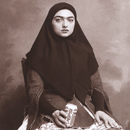
Shadi Ghadirian, from the series 'Qajar'
Shadi Ghadirian
Born Tehran, Iran, 1974. Lives Tehran
From the series 'Qajar'
1998
Gelatin silver print
Museum no. E.351-2010
Art Fund Collection of Middle Eastern Photography at the V&A and the British MuseumShadi Ghadirian was among the first students to graduate in photography from the Azad University, Tehran. Her work addresses concerns of Iranian women of her generation, exploring ideas such as censorship, religion and modernity, often with a wry humour.
The series 'Qajar' is based on a style of photograph made during Iran’s Qajar period (1786–1925). In those portraits, sitters posed with props representing their aspirations. Here, the sitters wear costumes that approximate Qajar fashion, but the objects they pose with are jarringly modern and western – a mountain bike, a stereo or a can of Pepsi. The contrast makes a comment on the tensions between tradition and modernity that women in Iran face today.
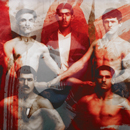
Bahman Jalali, 'Image of Imagination'
Bahman Jalali
Born Tehran, Iran, 1945. Died Tehran, 2010
'Image of Imagination'
2003
C-print
British Museum: 2009, 6036.1
Art Fund Collection of Middle Eastern Photography at the V&A and the British Museum
© Rana JavadiJalali was a photographer and teacher who played a leading role in collecting and preserving historical photographs in Iran. He was an influential teacher, mentored many of the younger generation of Iranian photographers, and was instrumental in setting up Tehran’s first Museum of Photography (also known as Akskhaneh Shahr).
In this montage he layered Qajar-period (1786–1925) portraits and an enlarged detail of an old photographic studio sign that had been crossed out with red paint. Jalali speculated that this defacement occurred during the Islamic revolution (1978–9), perhaps as an attack on a studio where unveiled women had been photographed.

Youssef Nabil, detail from 'The Yemeni Sailors of South Shields'
Youssef Nabil
Born Cairo, Egypt, 1972. Lives New York, USA
Detail from 'The Yemeni Sailors of South Shields'
2006
Hand-coloured gelatin silver print
British Museum: 2009, 6037.4
Art Fund Collection of Middle Eastern Photography at the V&A and the British MuseumYoussef Nabil's photographs and films evoke the glamour and melodrama of the golden age of Egyptian cinema in the 1940s and 50s, known as 'Hollywood on the Nile'. This is one of a dozen portraits made as part of a project to document the last surviving Yemeni men to settle as ship-workers in South Shields, in the north of England. The area is home to one of the oldest Muslim communities in the UK. Nabil hand-coloured the black-and-white photographs in the manner of mid 20th-century Egyptian studio portraiture.
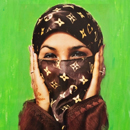
Hassan Hajjaj, 'Saida in Green'
Hassan Hajjaj
Born Larache, Morocco, 1961. Lives London, UK, and Marrakesh, Morocco
'Saida in Green'
2000
Digital c-print and tyre frame
Museum no. E.359-2010
Art Fund Collection of Middle Eastern Photography at the V&A and the British MuseumHajjaj is inspired by fashion photography, while also mocking its methods. He creates playful juxtapositions between global brand names and local motifs such as veils and babouches (traditional Moroccan slippers). The result is an exuberant collision of the stereotypical symbols of western consumerism and Middle Eastern tradition. The frames, which Hajjaj constructs from recycled materials, transform the photographs into three-dimensional, sculptural objects.
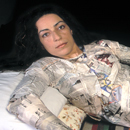
Raeda Saadeh, 'Who will make me real?'
Raeda Saadeh
Palestinian. Born Umm al Fahem, 1977. Lives Jerusalem
'Who will make me real?'
2003
Digital c-print
Museum no. E.356-2010
Art Fund Collection of Middle Eastern Photography at the V&A and the British MuseumIn her photographs, videos and performances, Raeda Saadeh assumes various roles to explore issues of displacement, gender and identity, with particular reference to the Israeli-Palestinian conflict. Here the artist lies in a pose that recalls 19th-century European paintings of reclining nudes. These often featured non-European women and 'Orientalist' costumes and scenery. Saadeh is encased in Palestinian newspapers, which conceal her body from neck to ankle while revealing its contours. The covering is both flimsy and apparently immobilising, resembling a papier-mâché body cast. Any sensuality implied by her pose is disrupted by the harsh realities reported in the newspaper.
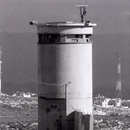
Taysir Batniji, from the series 'Watchtowers, West Bank/Palestine'
Taysir Batniji
Born Gaza, Palestine, 1966. Lives Paris, France, and Gaza
From the series 'Watchtowers, West Bank/Palestine'
2008
Inkjet prints
Museum nos. E.951-2010, E.952-2010, E.955-2010 & E.960-2010
Art Fund Collection of Middle Eastern Photography at the V&A and the British MuseumUsing a variety of media, including painting, sculpture, installation, photography and video, Taysir Batniji makes work that reflects his own experience of travelling between the European art world and Palestine.
The series 'Watchtowers' is inspired by the work of Bernd and Hilla Becher, the German photographers known for their meticulous documentation of industrial architecture. After seeing an exhibition of the Bechers’ work in Paris, Batniji decided to document in a similar way Israeli watchtowers in the Occupied Palestinian Territories. However, as a Gaza-born Palestinian, Batniji was not able to travel to the West Bank to make the pictures. He delegated the task to a local photographer. The photographs superficially resemble the Bechers’ work, but the limitations surrounding their making mean that they lack the same precision and clarity.
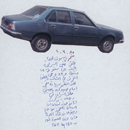
Walid Raad, 'Notebook Volume 38: Already Been in a Lake of Fire (Plates 63–64)'
Walid Raad
Born Chbanieh, Lebanon, 1967. Lives Beirut, Lebanon, and New York, USA
'Notebook Volume 38: Already Been in a Lake of Fire (Plates 63–64)'
2003
Inkjet Print
British Museum: 2007, 6033.1
Brooke-Sewell Permanent Fund
Image courtesy Anthony Reynolds Gallery, LondonWalid Raad works in photography, video, text, installation and performance. His work came to prominence with his influential project The Atlas Group (1989-2004), a fictional archive of documents relating to the contemporary history of Lebanon. For this major body of work, Raad explored the nature of documentary practice and the representation of political and social conflict. The images shown here are pages from the notebooks of a fictional historian named Dr Fakhouri. This character kept a log of every car that was used as a car bomb during the Lebanese civil war (1975–90).
Resisting
The artists in this section question the idea that a photograph can tell the truth. Some digitally alter images. Some scratch negatives and prints, or even burn them. Other artists reject clarity and detail in favour of processes that rely on chance. The results are murky, atmospheric images that require effort to interpret.
These manipulations demonstrate the fragility of the photograph, whether at the hands of artists or censors. They also lay bare the power of photographic imagery to influence and control through propaganda or surveillance. These works resist photography’s claim to accuracy and authority.
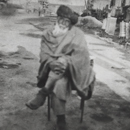
Atiq Rahimi, 'On the threshold of time (Au seuil du temps)', from the series 'The Imaginary Return (Le retour imaginaire)'
Atiq Rahimi
Born Kabul, Afghanistan, 1962. Lives Paris, France
'On the threshold of time (Au seuil du temps)', from the series 'The Imaginary Return (Le retour imaginaire)'
2002
Gelatin silver print
Museum no. E.967-2010
Art Fund Collection of Middle Eastern Photography at the V&A and the British MuseumAtiq Rahimi is a writer, film director and photographer who fled Afghanistan after the Soviet invasion in 1984, seeking political refuge in France, where he is now based. He returned to Afghanistan in 2002, after the fall of the Taliban. Confronted by the ruins of Kabul, he decided not to photograph the city with his digital camera. Instead he chose a primitive box camera normally used to take identity portraits in the streets of Kabul. The unpredictable process resulted in dreamlike photographs. They convey the nostalgia and brutal feelings of loss that Rahimi experienced when revisiting the war-wounded city.
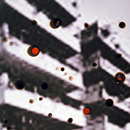
John Jurayj, 'Untitled (Large Embassy with Red Mirror #1)'
John Jurayj
Born Evanston, Illinois, USA, 1968. Lives New York, USA
'Untitled (Large Embassy with Red Mirror #1)'
2007
Inkjet print on watercolour paper, with burn holes and mirrored Plexiglas
British Museum: 2009, 6032.1
Art Fund Collection of Middle Eastern Photography at the V&A and the British MuseumUsing a variety of media, including painting, print-making, sculpture and video, John Jurayj explores the impact of the Lebanese civil war (1975-90), as both a world conflict and an identity trauma. He often re-works photographs of Lebanon from family albums, press archives and online databases. Here he translates the brutality of war into an attack on the photograph itself. He enlarges to near abstraction a news photograph of the bombed US embassy in Beirut in 1984. The image is further disrupted by the holes burnt into the paper. The holes are then filled in with red, mirrored Plexiglas.
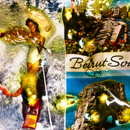
Joana Hadjithomas & Khalil Joreige, 'Wonder Beirut #13, Modern Beirut, International Centre of Water-skiing', from the series 'Wonder Beirut: The Story of a Pyromaniac Photographer'
Joana Hadjithomas & Khalil Joreige
Both born Beirut, Lebanon, 1969. Live Beirut and Paris, France
'Wonder Beirut #13, Modern Beirut, International Centre of Water-skiing', from the series 'Wonder Beirut: The Story of a Pyromaniac Photographer'
1997–2006
C-print mounted on aluminium with face mounting
Museum no. E.1124-2012
Art Fund Collection of Middle Eastern Photography at the V&A and the British Museum
Courtesy of the artists and CRG Gallery, New York and In Situ / Fabienne Leclerc, ParisJoana Hadjithomas and Khalil Joreige collaborate as filmmakers and artists, producing cinematic and visual art work that intertwine. In the series 'Wonder Beirut' they use photography to blur fact and fiction. The artists noticed that tourist postcards of pre-civil war Beirut were still for sale after the war ended in 1990. They invented a fictional photographer named Abdallah Farrah who, in 1968, was commissioned by the tourist board to make postcard views of Beirut’s attractions. When the civil war broke out in 1975, he began to burn his negatives to reflect the surrounding destruction. The artists present these works as prints from the fictional photographer’s damaged negatives.
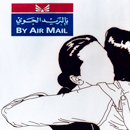
Jowhara AlSaud, 'Airmail', from the series 'Out of Line'
Jowhara AlSaud
Born Jeddah, Saudi Arabia, 1978. Lives Jeddah and New York, USA
'Airmail', from the series 'Out of Line'
2008
C-print
Museum no. E.948-2010
Art Fund Collection of Middle Eastern Photography at the V&A and the British MuseumJowhara AlSaud's photographs explore the language of censorship and the malleability of photography. AlSaud scratches the outlines of figures from her personal photographs into photographic negatives, which she then prints. By reducing the figures to line drawings she renders them anonymous. The embracing figures hint at farewells and longing. The envelopes suggest thwarted attempts at communication. AlSaud's hybrid technique of drawing and photography critiques the censorship of visual communication in Saudi Arabia.
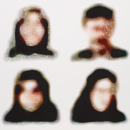
Taraneh Hemami, 'Most Wanted'
Taraneh Hemami
Born Tehran, Iran, 1960. Lives San Francisco, USA
'Most Wanted'
2006
Hand-manipulated pigment print
British Museum: 2009, 6030.1
Art Fund Collection of Middle Eastern Photography at the V&A and the British MuseumTaraneh Hemami explores issues of cultural identity, preservation and representation, specifically among the Iranian/Iranian-American diaspora community. She often starts with personal or communal archival material and remakes it in a variety of media, while drawing attention to the crafting of images for propaganda purposes.
This work is based on mugshots downloaded from a US government website shortly after 9/11. Hemami digitally manipulates the faces to such an extent that any identifying features of the individuals are blurred away. She further defaces the images by scratching into the surface of the print. The sparse visual information that remains, such as headscarves, suggests western stereotypes of Muslims.
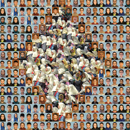
Sadegh Tirafkan, 'Human Tapestry'
Sadegh Tirafkan
Born Karbala, Iraq, 1965. Lives Tehran, Iran
'Human Tapestry'
2009
Digital c-print
British Museum: 2011, 6033.1
Maryam and Edward Eisler collection of Iranian Art at the British MuseumSadegh Tirafkan draws on historical Iranian imagery to investigate issues of identity, gender and culture. Tirafkan often incorporates self-portraiture into his work, which has the role of the male in traditional Iranian culture as one of its main themes. Here, hundreds of individual portraits make up this digital Persian carpet, which the artist intends as a comment on population growth in Iran. The photographs no longer function as individual likenesses. They are treated as raw material, like the tiles of a mosaic or the scraps of fabric that make up a patchwork quilt. Tirafkan defies the specificity of the people pictured and uses them to form abstract patterns.
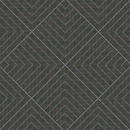
Camille Zakharia, 'Markings II'
Camille Zakharia
Born Tripoli, Lebanon, 1962. Lives Manama, Bahrain
'Markings II'
2008
Inkjet print on rag paper
Museum no. E.671-2011Using photography, photomontage, collage, painting and print, Camille Zakharia makes work about identity and displacement, reflecting his own life journey and his interest as a trained engineer in architecture and the urban landscape.
In this work Zakharia digitally manipulates his source material until it is nearly illegible. He creates an abstract geometric form that is reminiscent of the patterns on Islamic tiles. The shape was made by repeating and rotating a photograph of a line of paint on asphalt. He explains, 'Through the use of montage, I have rebelled against the photo medium itself, challenging its reputation to represent reality as it is. I have liberated myself from the traditional photo process.'
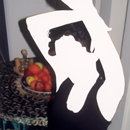
Amirali Ghasemi, from the series 'Party'
Amirali Ghasemi
Born Tehran, Iran, 1980. Lives Tehran
From the series 'Party'
2005
Digital c-print
Museum no. E.355-2010
Art Fund Collection of Middle Eastern Photography at the V&A and the British MuseumAmirali Ghasemi studied Graphic Design at Azad University, Tehran and in 1998 founded Parkingallery, an independent project space, art collective and graphic design studio. In 2002 he launched Parkingallery.com, an online platform for Iranian artists.
In the series 'Party', Ghasemi alters what look like ordinary, spontaneous snapshots by blocking out exposed areas of flesh. By pre-emptively censoring his own images, he protects the identity of individuals photographed at unsanctioned private parties. The work evokes the censorship of imported magazines in Iran, where skirts are lengthened and women’s bodies are covered with strokes of black marker.

Şükran Moral, 'Despair'
Şükran Moral
Born Terme, Turkey, 1962. Lives Rome, Italy, and Istanbul, Turkey
'Despair'
2003
Digital c-print
British Museum: 2010, 6032.1
Art Fund Collection of Middle Eastern Photography at the V&A and the British MuseumŞükran Moral works in photography, sculpture, video and performance, creating bold and often controversial works that critique society and its institutions. Violence against women is a major theme. She has also made work about other groups who lack societal power, including the mentally ill, children, immigrants and prostitutes.
In this image, brightly-coloured birds, what Moral calls 'digital nightingales', perch on a group of migrant workers huddled in a boat. According to the artist, in Turkish literature nightingales are a symbol of hope, love and separation. The men and boys are shown in black-and-white, at the mercy of their situation. The birds, however, are free to fly away.

Nermine Hammam, 'Armed Innocence II', from the series 'Upekkha'
Nermine Hammam
Born Cairo, Egypt, 1967. Lives Cairo
'Armed Innocence II', from the series 'Upekkha'
2011
Archival inkjet print
Museum no. E.1131-2012
Art Fund Collection of Middle Eastern Photography at the V&A and the British MuseumInfluenced by a background in film and graphic design, Nermine Hammam works in series, making prints that combine elements of painting and photography, often digitally manipulating and layering images to represent subjects in states of abandonment or altered consciousness. When the army was called in to respond to the protests in Cairo’s Tahrir Square in January 2011, Hammam was struck by the vulnerability of the soldiers. They seemed to want to be anywhere but there. In the 'Uppekkha' series she transports these soldiers into vibrant fantasy settings. Reminiscent of postcards, the series likens the events of Tahrir Square to a tourist attraction that drew the world's attention, but was not fully understood.
In this film five of the artists whose work is included in the exhibition - Abbas, Manal Al-Dowayan, John Jurayj, Nermine Hammam and Hassan Hajjaj, explain central themes and aims of their work, their background and the significance of being a Middle Eastern artist working and exhibiting at an international level.

Contents
A gift in your will
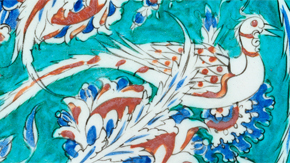
You may not have thought of including a gift to a museum in your will, but the V&A is a charity and legacies form an important source of funding for our work. It is not just the great collectors and the wealthy who leave legacies to the V&A. Legacies of all sizes, large and small, make a real difference to what we can do and your support can help ensure that future generations enjoy the V&A as much as you have.
More